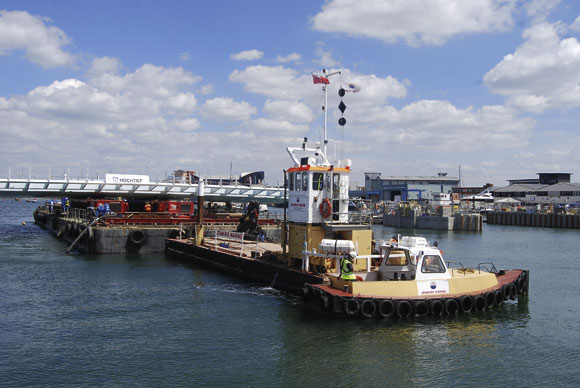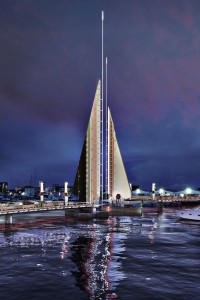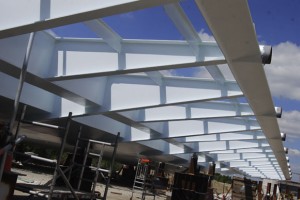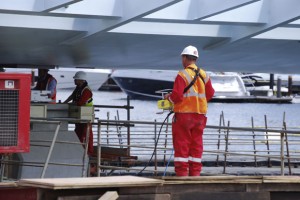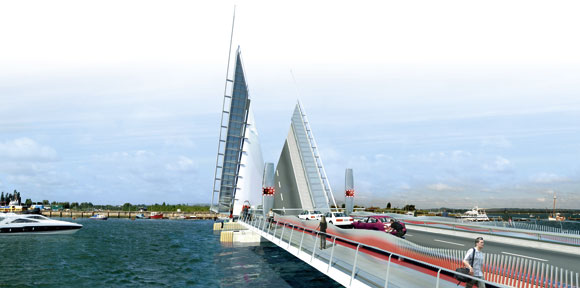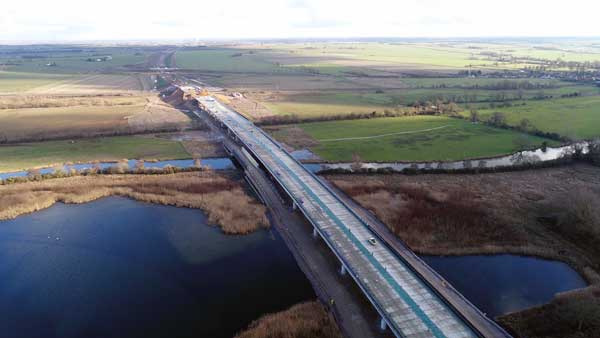Projects and Features
Harbour bridge floated into place
Poole Harbour’s new and iconic second crossing will open to traffic next year. Martin Cooper reports on the complex erection process required to construct the bridge.
FACT FILE: Poole Harbour Second Crossing, Dorset
Main client: Borough of Poole
Architect: Wilkinson Eyre Architects
Main contractor: Hochtief Construction
Structural engineer: Gifford, part of Ramboll
Steelwork contractor: Cleveland Bridge
Steel tonnage: 1,000t
Project value: £11M
This month (October) will see the completion of the steelwork erection for the iconic ‘Twin Sails’ bridge which spans Holes Bay in Poole, providing a much needed second crossing for the Dorset town’s busy harbour, as well as being an important component for regeneration.
Connecting Poole Old Town to Lower Hamworthy, the bridge will have to open almost hourly for maritime traffic and therefore the design has been driven by the need for robustness and reliability.
The new low level bridge has five spans, with the mid-span able to divide in half as two lifting elements. Structurally the bridge is designed and configured as a simple bascule, with a flat concrete deck and two hydraulically operated lifting sections.
Normally the joint between lifting sections is transverse, but on this structure it is skewed across the deck creating two triangular leaf-like segments. It is these triangular moveable parts, mirroring the shape of yachts when in their open upright position, that make the Poole bridge unique and accounts for its ‘Twin Sails’ nickname.
“There are no other structures in the vicinity, so being a low level bridge it blends into the landscape,” explains Steve Thompson, Design Project Manager for Gifford. “However, drama unfolds when it opens at mid-span to reveal it’s elegant yet simple maritime shape.”
Work on this prestigious project was begun by main contractor Hochtief during the summer of 2010, and the company expects to handover the completed bridge early next year. Getting the project off the ground was at times a tortuous affair, as the current design initially won a design competition way back in 2001. Thereafter the project stalled due to costs, but last year funding was sorted out and work was able to begin.
Site offices and a steel assembly yard have been set up on a brownfield site, formerly a power station, on the Hamworthy side of the Bay. It is on this bank that the preliminary steel construction work has been done. Steelwork contractor Cleveland Bridge has delivered more than 40 steel sections to the site and assembled them into five bridge spans, before transporting them onto barges which then help to position them on the piers and abutments.
According to Mr Thompson steel was the only option for this project as the bridge needed to be a lightweight structure that could open at least 15 times a day. A low level bridge which mirrored the height of the quayside was another important design criteria best achieved with steel.
The quaysides on both banks of the harbour are old structures and in places in an uncertain condition. By building a lightweight bridge, and constructing it in sections which are floated into position using the tidal movements, time-consuming and costly surveys and possible strengthening works to the quayside has been negated.
The construction of the bridge has also captured the local population’s imagination, and to this end the local council has set up a public viewing area, on the opposite bank, to allow local residents to watch the project unfold.
The steel sections for the bridge have all been fabricated at Cleveland Bridge’s Darlington facility and transported by road to Poole. The company initially assembled the first three spans of the bridge and positioned them during July. This work took place soon after the western support piers and abutment had been completed by the project’s specialist marine piling contractor.
“We have to keep the harbour open to maritime traffic at all times,” says Ben Binden, Cleveland Bridge Project Manager. “So working from the western bank we first erected three spans, which included the two lifting segments for the central span. Once the hydraulic lifting gear is installed and commissioned we will be able to erect the final two spans, as boats will then be able to access and exit the harbour via the new bridge’s lifting channel.”
Although the spans vary in length (span one and five are 28m-long, two and four are 18m-long and the lifting central span is 30m-long, divided into two 15m-long segments) they were all, with the exception of the central span, assembled on site from four large box sections and four walkway sections, welded together to form a 5m wide span. Each half of the central span was assembled from two large box sections and two outer walkway sections to form a triangle.
Once each span had been fully welded and painted they were ready to be positioned. Although the on-shore fabrication process was complicated it did significantly reduce the amount of work which needed to be undertaken over the water. Only one welded splice was needed between each erected span.
Each completed span was loaded onto a self-propelled mobile transporter (SPMT) which then carried it the short distance down to the water’s edge and onto a flat-deck barge.
SPMTs are large multi-wheeled vehicles which are able to pick-up the spans via hydraulic jacks, and raise and lower the spans into position. The spans were all driven onto the barge with the deck positioned perpendicular to its final position.
Once the barge was in the bay, tugs helped nudge the barge into position so the span was positionally aligned with its final bearings.
However, before the final positioning could take place the construction team had to wait for the correct tide. “Each span was taken onto a barge via an access ramp from our assembly point,” explains Mr Binden. “The barge then had to wait for high tide before moving the span into a position above and between its supports.”
Floating each span was a tricky procedure but they were all successfully completed. “The spans were positioned above their final bearings, using a combination of the SPMTs jacks and tidal range between high and low tides, each of the spans have been lowered into place successfully,” sums up Mr Binden.








